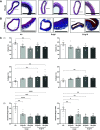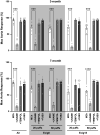Maternal electronic cigarette use during pregnancy affects long-term arterial function in offspring
- PMID: 36417201
- PMCID: PMC9762967
- DOI: 10.1152/japplphysiol.00582.2022
Maternal electronic cigarette use during pregnancy affects long-term arterial function in offspring
Abstract
Vaping, or electronic cigarette (ecig) use, is prevalent among pregnant women, although little is known about the effects of perinatal ecig use on cardiovascular health of the progeny (even when using nicotine-free e-liquid). Maternal toxicant inhalation may adversely affect vital conduit vessel development. We tested the hypothesis that perinatal exposure to maternal vaping would lead to a dose-dependent dysfunction that would persist into later life of offspring. Pregnant Sprague-Dawley rats were exposed to either nicotine-free (ecig0) or nicotine-containing ecig aerosol (18 mg/mL, ecig18) starting on gestational day 2 and continued until pups were weaned (postnatal day 21). Pups were never directly exposed. Conduit artery function (stiffness and reactivity) and structure were assessed in 3- and 7-mo-old offspring. At 3 mo, pulse wave velocity (PWV) in the ecig0 and ecig18 offspring was significantly higher than controls in both the 20 puffs/day (6.6 ± 2.1 and 4.8 ± 1.3 vs. 3.2 ± 0.7 m/s, respectively, P < 0.05, means ± SD) and in 60 puffs/day exposure cohort (7.5 ± 2.8 and 7.5 ± 2.5 vs. 3.2 ± 0.5 m/s, respectively, P < 0.01). Wire myography revealed (range of 23%-31%) impaired aortic relaxation in all ecig exposure groups (with or without nicotine). Incubation of vessels with TEMPOL or Febuxostat reversed the aortic dysfunction, implicating the involvement of reactive oxygen species. Nearly identical changes and pattern was seen in vascular outcomes of 7-mo-old offspring. The take-home message from this preclinical study is that maternal vaping during pregnancy, with or without nicotine, leads to maladaptations in vascular (aortic) development that persist into adult life of offspring.NEW & NOTEWORTHY We observe a significant alteration in arterial structure and function in adolescent and adult offspring due to developmental exposure to toxicants resulting from perinatal maternal vaping. Taken together with previous work that described lasting dysfunction in cerebral microvasculature in offspring, these data underscore the adverse consequences of maternal exposure to electronic cigarette aerosol in conduit and resistance vessels alike, irrespective of nicotine content.
Keywords: aorta; arterial stiffness; in utero; vaping; vascular reactivity.
Conflict of interest statement
No conflicts of interest, financial or otherwise, are declared by the authors.
Figures






References
-
- Kurti AN, Redner R, Lopez AA, Keith DR, Villanti AC, Stanton CA, Gaalema DE, Bunn JY, Doogan NJ, Cepeda-Benito A, Roberts ME, Phillips J, Higgins ST. Tobacco and nicotine delivery product use in a national sample of pregnant women. Prev Med 104: 50–56, 2017. doi:10.1016/j.ypmed.2017.07.030. - DOI - PMC - PubMed
-
- Kapaya M, D'Angelo DV, Tong VT, England L, Ruffo N, Cox S, Warner L, Bombard J, Guthrie T, Lampkins A, King BA. Use of electronic vapor products before, during, and after pregnancy among women with a recent live birth - Oklahoma and Texas, 2015. MMWR Morb Mortal Wkly Rep 68: 189–194, 2019. doi:10.15585/mmwr.mm6808a1. - DOI - PMC - PubMed
Publication types
MeSH terms
Substances
Grants and funding
LinkOut - more resources
Full Text Sources
Medical

